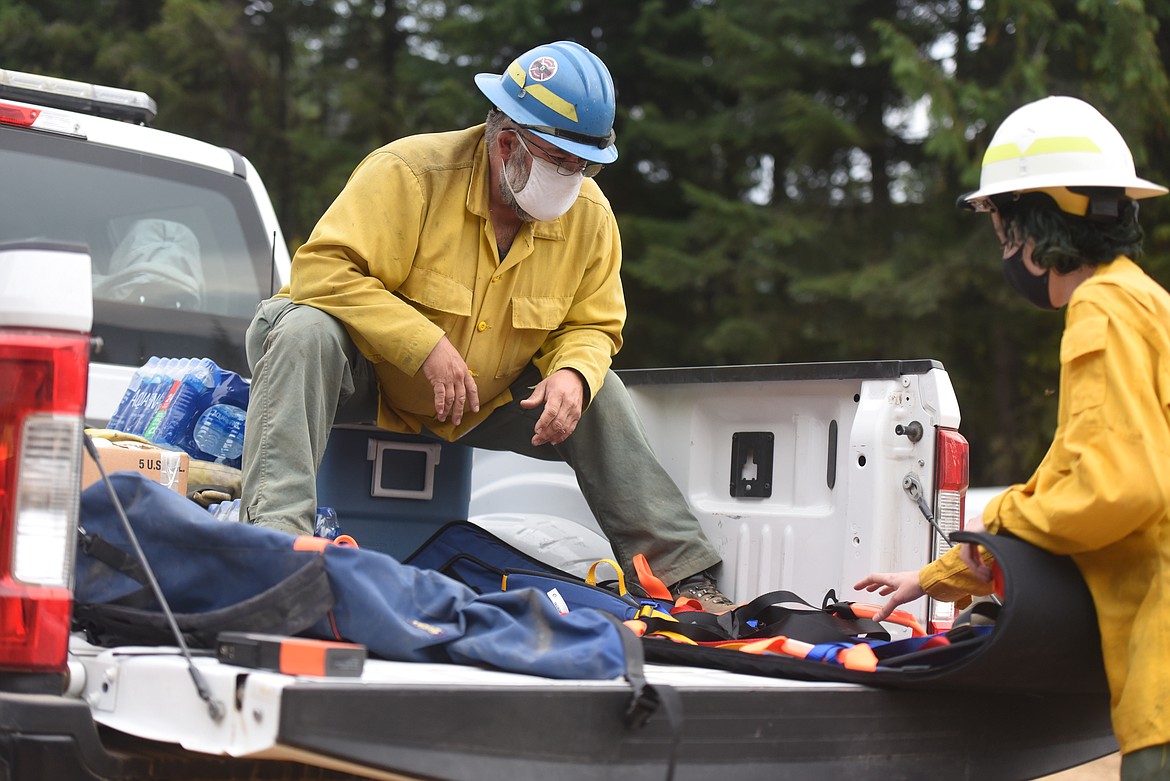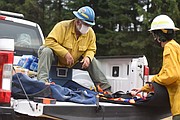COVID-19 complicates wildfire response
As they continue to battle the Callahan fire near Troy, officials are managing hundreds of firefighters and dozens of pieces of machinery drawn from multiple states. While challenging under any circumstances, the task of coordinating these resources in the midst of the COVID-19 pandemic has created unique administrative headaches.
“It’s hindered us as far as certain things,” said Ronnie Hayes, logistics section chief for the interagency group responsible for managing the fire.
On Sept. 24, 258 firefighters with the Northern Rockies Incident Management Team Seven had the 1,276 fire at 60 percent contained. As they continued to mop up the smoldering fire, crews received assistance from six engines, one water tender, five pieces of heavy equipment and three helicopters.
Most of these firefighters along with operations staff were camped out at the team’s incident command post. Located in a field off Montana Highway 56 a couple miles south of the way station, the post consists of scores of single tents interspersed around a handful of yurts. Portable toilets and trailers with sinks and showers dot the camp and a canopy tent serves as the team’s command center.
Pointing out the tent which housed the team’s dining facility, Hayes said that normally the firefighters would eat together in a mess hall. Under COVID-19 guidelines, however, officials package the meals separately at the facility for the firefighters to eat at their tents.
Officials have also restructured the command center. Usually, the team would hold meetings indoors but during the pandemic, Hayes said they have had to hold them outdoors while standing six feet apart with masks.
Hayes said team leaders would stress the importance of wearing masks at each brief.
As an extra measure of precaution, a crew is assigned to wipe down door handles and tables in the camp every hour.
“It’s changed how we operate,” said Hayes. “We wouldn’t normally have this many tents but … we’ve had to scale up the camp so it's safe for everyone.”
Justin Pilkington and Sam Westlin, both firefighters from Eureka, had been living at the camp for seven days as of Sept. 23. Overall, they said adapting to the new guidelines had not been a significant challenge for them.
“It’s just a different protocol,” Pilkington said.
For Corey Graham, an engine boss based out of Eureka, the COVID-19 guidelines at the Callahan post were more manageable than other fire camps he had worked out of this summer.
While fighting the Pine Gulch Fire in Colorado in July, Graham said he and his crew had to manage much of their tasks through their phones.
“Here we can actually go to people as long as we keep our distance,” he said.
While most crews on the Callahan fire spent their nights at the command post, some firefighters were camped out at secondary sites. Daniel Gray, a firefighter attached to a short haul helicopter crew out of Helena, said he and the rest of his squad were staying at a nearby helibase.
As a highly specialized crew, Gray said his team was being especially careful to isolate themselves.
“We have a medical responsibility with our helicopter,” Gray said. “If we get shut down, then that’s one of four ships nationally for short haul medical purposes that will be out of commission for two weeks.”
On some fires this year, officials have spread out all of their crews between multiple campsites. The practice — known as spiking — has not possible on the Callahan fire due to the terrain.
On Sept. 8, an engine crew on patrol first spotted the blaze roaring up the steep timbered slopes of the South Callahan Drainage. Concentrated in a burn scar from 1992, the fire spread to 1000 acres by Sept. 12. When smoke from blazes in neighboring states cleared by Sept. 20, firefighters were able to rapidly start containing the fire.
Forest Service officials have closed Callahan Creek Road from the junction with Ruby Three Mile Road, Snowstorm Road, South Fork Callahan Creek Road, Goat Creek Road, Smith Mountain Road and Glad Creek Road. Trail closures include Goat Creek, South Fork Callahan, Smith Mountain, Smith Lake, Roberts Mountain, Caribou Creek and North Fork Callahan.
Forest Service officials said the fire was human-started. While Justin Erickson, former incident commander, said the blaze likely originated from a campfire at the base of Smith Mountain the investigation into the ignition source is still ongoing.




